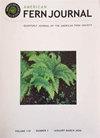短音符
IF 0.9
4区 生物学
Q4 PLANT SCIENCES
引用次数: 1
摘要
美洲凤头藤变种(凤头藤科)产于美国新墨西哥州。美洲鹿舌蕨(美洲鹿舌蕨)是北美蕨类植物群中最独特和最稀有的成员之一。1807年Frederick Pursh首先在纽约锡拉丘兹附近发现了这个分类群的新种群,由于它的稀有,不寻常的分布,以及与著名的欧洲鹿舌蕨A. scolopendrium var. scolopendrium L.的密切关系,引起了相当大的兴趣。在Pursh最初的发现之后,在田纳西州发现了更多的种群(Williamson, Bulletin of the Torrey植物学俱乐部:347 - 348)。1879),安大略省(Soper,美国蕨类杂志44:129-147。1954),阿拉巴马州(短,美国蕨类杂志69:47-48。(Futuyma, American Fern Journal 70:81-87)。1980)。在美国已知的地方,该物种受濒危物种法案(ESA)的保护,主要局限于五大湖地区石灰岩悬崖上有厚厚的湖泊效应积雪的地区,在美国东南部的石灰岩天坑和洞穴中有少量分离的种群。来自墨西哥和海地的植物有时被视为一个独特的品种(在分离属Phyllitis中被称为P. scolopendrium var. lindenii (Hook.))。甚至一个不同的物种(P. lindenii (Hook.))。Maxon),但除了地理之外,几乎没有证据支持它们与A. scolopendrium变种美洲的独特性,并且在最近的处理中,它们被视为后者的同义词(例如,Mickel和Smith, Pteridophytes of Mexico, 2004)。即使在这个更广泛的分类概念下,美洲的鹿舌蕨也被限制在一些分散的地方,自1983年在墨西哥Nuevo León发现植物以来,没有重大的范围扩展的报道(arreguyi n-Sánchez and Aguirre-Claverán, phytoogia 60:399-403)。1986)。2017年2月,我们中的两个人(L. Baumann和E. Weaver)在新墨西哥州西博拉县格兰特附近的El Malpais国家纪念碑的一个小熔岩管内的一个受保护的微型遗址中发现了一群a . scolopendrium。该遗址是在对与麦卡蒂斯熔岩流相关的洞穴特征进行定期调查时发现的,该熔岩流包括ZuniBandera火山场最年轻的部分(邓巴和菲利普斯,新墨西哥州地质16:80)。1994)。2020年2月,五位作者协调了一次调查人口的旅行,并寻找其他可能的地点。一场暴风雪推迟了这次旅行的开始,几乎导致旅行取消,但情况稳定下来,我们在下午早些时候就能到达现场。即使在良好的天气条件下,也很难找到牛头蒿的种群;要到达这里需要开车40公里,还要徒步近2公里,穿过一片熔岩地带本文章由计算机程序翻译,如有差异,请以英文原文为准。
SHORTER NOTE
Asplenium scolopendrium var. americanum (Aspleniaceae) Found in New Mexico, USA.—Asplenium scolopendrium var. americanum (Fernald) Kartesz & Gandhi (the American hart’s-tongue fern) is among the most distinctive and rarest members of the North American fern flora. First discovered near Syracuse, New York by Frederick Pursh in 1807, reports of new populations of this taxon have drawn considerable interest, due to its rarity, unusual distribution, and close relation to the well-known European hart’s-tongue fern, A. scolopendrium var. scolopendrium L. Following Pursh’s initial discovery, additional populations were found in Tennessee (Williamson, Bulletin of the Torrey Botanical Club 6:347–348. 1879), Ontario (Soper, American Fern Journal 44:129–147. 1954), Alabama (Short, American Fern Journal 69:47–48. 1979), and Michigan (Futuyma, American Fern Journal 70:81–87. 1980). Known localities in the United States, where the species is protected under the Endangered Species Act (ESA), are mostly restricted to areas with heavy lake-effect snow on limestone escarpments in the Great Lakes region, with small disjunct populations in limestone sinkholes and caves in the southeastern US. Plants from Mexico and Haiti have sometimes been treated as a distinct variety (in the segregate genus Phyllitis as P. scolopendrium var. lindenii (Hook.) Fernald) or even a different species (P. lindenii (Hook.) Maxon) but little evidence apart from geography has been presented to support their distinctiveness from A. scolopendrium var. americanum, and they have been treated as synonyms of the latter in recent treatments (e.g., Mickel and Smith, Pteridophytes of Mexico, 2004). Even under this broader taxonomic concept, the American hart’s-tongue fern is restricted to a few scattered localities, and no significant range extensions have been reported since the discovery of plants in Nuevo León, Mexico, in 1983 (Arreguı́n-Sánchez and Aguirre-Claverán, Phytologia 60:399–403. 1986). In February 2017, two of us (L. Baumann and E. Weaver) found a population of A. scolopendrium growing in a protected microsite within a small lava tube in El Malpais National Monument, near Grants, Cibola County, New Mexico. The site was discovered during regular surveys of cave features associated with the McCartys lava flow, which comprises the youngest portion of the ZuniBandera volcanic field (Dunbar and Phillips, New Mexico Geology 16: 80. 1994). In February 2020, the five authors coordinated a trip to survey the population and search for additional possible localities. A snowstorm delayed the start of the trip and nearly caused its cancellation, but conditions settled and we were able to get in the field by early afternoon. Even in good weather conditions, finding the A. scolopendrium population would be difficult; reaching it involves a 40km drive and hiking nearly 2km across a lava field of
求助全文
通过发布文献求助,成功后即可免费获取论文全文。
去求助
来源期刊

American Fern Journal
生物-植物科学
CiteScore
1.20
自引率
0.00%
发文量
28
审稿时长
6 months
期刊介绍:
The American Fern Journal is a peer-reviewed journal focused on the biology of ferns and lycophytes.
 求助内容:
求助内容: 应助结果提醒方式:
应助结果提醒方式:


